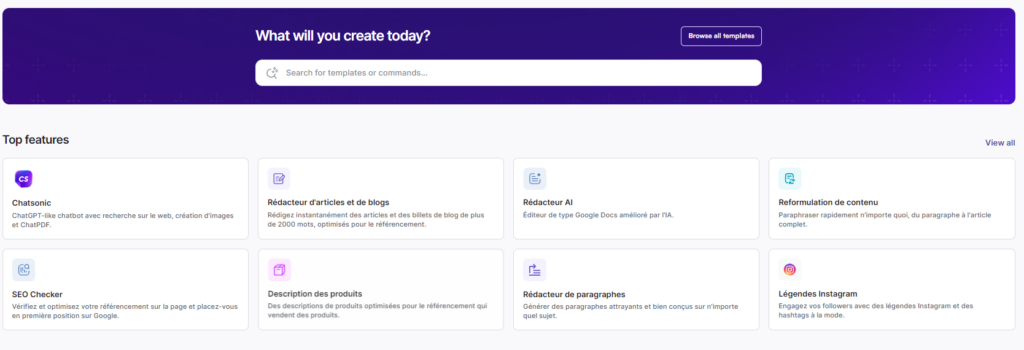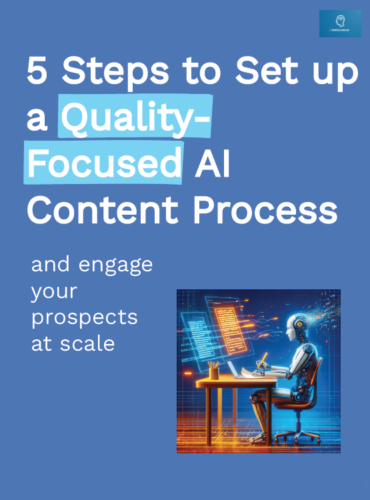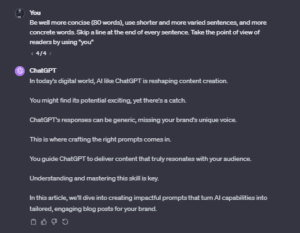Writesonic promotes itself as the do-it-all content platform. The company doesn’t hesitate to integrate a variety of features to handle many use cases.
But how does it far against ChatGPT in terms of productivity gains and output quality?
From my own experience and observations, here’s a comparative analysis of both tools for content marketers and creators.
ChatGPT vs Writesonic: comparison of the features
Let’s start by examining the features of both tools, to see what they both enable you to do.
Writesonic

Writesonic is definitely one of the content creation tools offering the widest range of features in the market. Here are the most prominent ones :
- Chatsonic: it basically copies the chatbot interface of ChatGPT. You can engage with it to handle any task or application with precise prompts.
- Photosonic: you can generate pictures from specific prompts based on Stable Diffusion 2.
- Audiosonic: you can create voiceover from a written text in multiple languages and tailored voices.
- Brand voice and knowledge: Based on an extract, a link, or a document, Writesonic can memorize your brand knowledge and replicate your desired brand tone.
- Botsonic: Like custom GPTs, you can even create a personalised bot that can answer your client’s queries or help you generate content tailored to your brand.
- AI Article writer: this custom interface enables you to create detailed and knowledgeable, and SEO-optimized articles based on online knowledge.
- SEO Optimizer: there is even a tool that measures how much your content is optimized for specific SEO keywords.
- Templates: Writesonic also provides you with a tone of templates to streamline many types of content use cases. These pre-made prompting templates enable you to generate Social media captions, ad copies, product descriptions, blog articles, etc…
ChatGPT

ChatGPT serves as the user-friendly chatbot interface for the advanced language models GPT-3.5 and GPT-4. This versatile application supports a wide array of uses, excelling particularly in content creation when leveraged with precise prompts.
The application boasts several key features:
- Chat Interface: Engage in conversations with ChatGPT on any topic, and receive informative and coherent responses.
- Web Browsing Capabilities: Use ChatGPT’s ability to fetch and summarize information from the web via Bing searches, enhancing your content with up-to-date insights.
- Data Interpreter: Request ChatGPT to perform calculations, generate data visualizations, write code, or create various types of files, streamlining complex tasks.
- DALL-E Integration: In its premium version, ChatGPT includes access to DALL-E’s image generation features, enabling users to request and refine images to complement their content visually.
- Custom GPTs: Tailor ChatGPT to your specific needs by setting up custom versions of the tool that adhere to your brand’s voice and knowledge base, offering a personalized experience.
Which tool is best for your use case?
Let’s say that both tools cover a wide range of use cases.

ChatGPT enables you to produce a wide range of output, as long as you know the right prompts to get the right results. You can generate blog posts, social media posts, product descriptions, landing pages, ad copies… You name it.
Besides that, ChatGPT also provides detailed photo generation with DALL-E 3 and customized chatbots with custom GPTs.
Writesonic covers the same use cases but with tailor-made and ready-to-use features. Article writers help you create high-quality blog articles, Chatsonic customized voice-over, and Photosonic generate photos. These are all made by Writesonic developers to specifically help non-savvy users produce high-quality AI pieces without prior prompt mastery.
Which tool is the most productive for content creation?
When it comes to content process efficiency and quality, the battle is getting more tense and harder to call.
My personal preference has always been ChatGPT. With ChatGPT, you can build your own prompting process without constraints while directly leveraging the most powerful AI model on the market (the latest version of GPT-4).
As a result, you can generate high-quality content as long as you know how to apply the right prompt at the right moments. You can customize ChatGPT’s tone and style to your brand guidelines and audience’s expectations. My method is especially to provide it with specific brand guidelines and a well-chosen written sample to get it going. Then I ask it to write the actual content based on an outline or some draft ideas. This helped me implement a content process to create quality pieces at a fast scale.
Writesonic is all about ease of use and quick deployment. The AI article writer for example is a great tool for creating high-quality articles in one single click. You only have to give the title of your article and the keyword you want to rank on, and it will scrape the highest-ranking articles to build an SEO-optimized piece of content.

Writesonic shines the most by providing these pre-made interfaces for your content use cases. Writesonic has been developing these interfaces for content rephrasing, social media ads, title generation, and e-commerce product descriptions, and their result are interesting. Be wary of using GPT-4 in the paid version, though. The “premium” generation is quite bad, and you’ll get better results with the latest model.

What’s my conclusion? The productivity gains will depend on your prompting abilities. If you already handle prompts quite well, you’ll be able to do many things with ChatGPT. Otherwise, if you want fast reliable results, you can leverage Writesonic built-in templates to get compelling results more easily.
ChatGPT and Writesonic: which has the best value for money?

ChatGPT presents a variety of subscription options, each tailored to provide distinct features and resources to enhance your content creation journey:
- Free Plan: Ideal for those dipping their toes into AI-driven content creation, the Free Plan offers unlimited messaging access to the GPT-3.5 model across web, iOS, and Android platforms. While it’s cost-free, be prepared for slower response times and the absence of the more advanced GPT-4 model capabilities. This plan is well-suited for individuals testing AI content strategies or managing smaller scale projects.
- Plus Plan: At $20 monthly per user, the Plus Plan elevates your content creation with access to the GPT-4 model, promising quicker responses and a wider context window for producing richer, more intricate content. Subscribers benefit from additional features like DALL·E for image creation, web browsing for research, and sophisticated data analysis tools. Note the 30-request limit every three hours, necessitating strategic planning in content production.
- Team Plan: Tailored for content marketing teams, the Team Plan costs $25 per user per month (annual billing) or $30 per user on a monthly basis. It builds on the Plus Plan’s offerings with increased message limits, an admin console for efficient workspace management, and stringent data privacy controls to safeguard your team’s information. This plan is ideal for teams seeking to deeply integrate AI into their content marketing efforts.
- Enterprise Plan: For extensive content marketing divisions looking for a customizable, secure, and scalable AI solution, the Enterprise Plan provides tailored pricing to accommodate your organization’s specific requirements. It grants unlimited GPT-4 access, an extended context window for comprehensive content development, and top-tier security measures to ensure data protection. This plan represents the pinnacle option for large-scale content marketers aiming to maximize AI utilization.
Writesonic offers a variety of pricing plans tailored to different needs and budgets, from individuals and freelancers to small teams and large enterprises. Here’s a breakdown of their current pricing structure:
- Free Plan
- Cost: $0 per month
- Users: 1
- Words: 10,000 per month
- Model: Only GPT 3.5
- Key Features: Chatsonic, AI Article Writer 4.0, Sonic Editor, Photosonic, Complete Article Rewriter, browser extensions, 100+ AI templates, 1-Click WordPress Export, Zapier Integration, support for 30 languages.
- Freelancer Plan
- Cost: $20 per month
- Users: 1
- Words: Unlimited
- Model: Only GPT 3.5
- Benefits: All features of the Free plan plus unlimited word generation.
- Small Team Plan
- Cost: Ranges from $19 to $499 per month
- Users: 1 to 5
- Words: 100,000 to 4,000,000
- Model: GPT 3.5 or GPT-4
- Additional Features: Larger word limits, access to GPT-4 models, factual and personalized article writer with AI Article Writer 5.0, 5 brand voices, higher quality image generation, API access, bulk processing, priority feature access, priority support.
- Enterprise Plan
- Cost: $500+ per month
- Special Features: SSO/SAML Login, custom templates, priority AI processing, customer success manager, training sessions, user provisioning via SCIM (coming soon), audit log (coming soon), workspace analytics (coming soon), premium support.
So which has the best value for money?
Writesonic generally offers a more diverse range of plans that can be tailored to different sizes and needs, including unlimited word counts at lower-tier plans, which is particularly valuable for high-volume content production.
ChatGPT shines for users requiring advanced model capabilities (GPT-4) and specific features like image generation with DALL·E, browsing capabilities, and advanced data analysis, albeit at a higher cost and with usage limitations.
Ultimately, the best value for money depends on the specific needs of the content marketers.
Those prioritizing advanced AI features and model capabilities might find ChatGPT more valuable, whereas those focusing on ease-of-use and versatility might lean towards Writesonic.
You’ll need to assess their specific needs, including the types of content they produce, volume, and the importance of advanced AI features, before making a decision.
Here’s everything I could give you about these tools. Now try them out by yourself !





